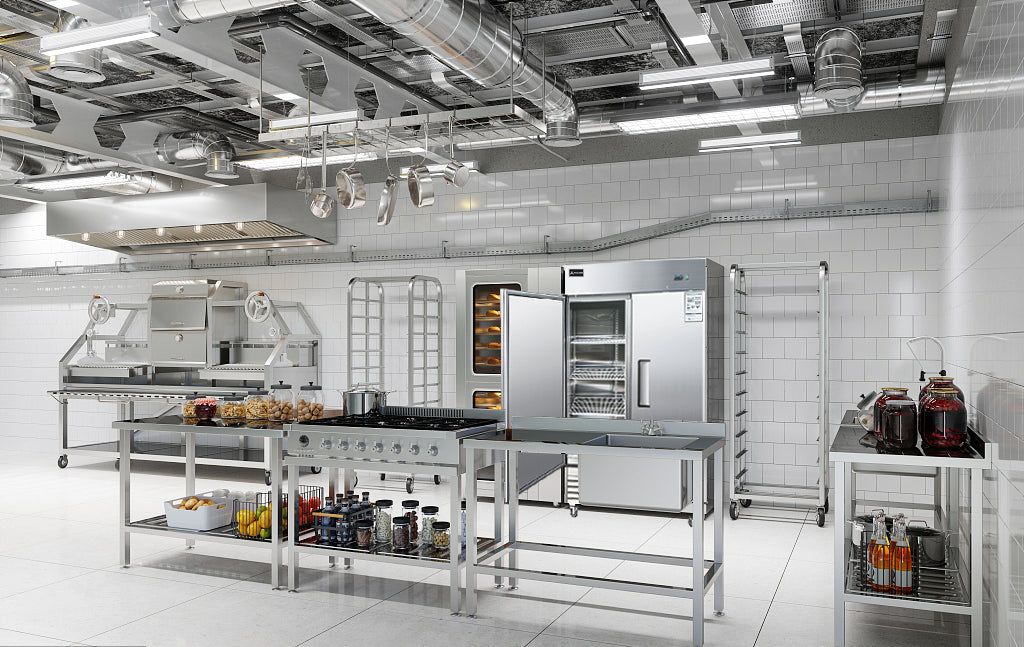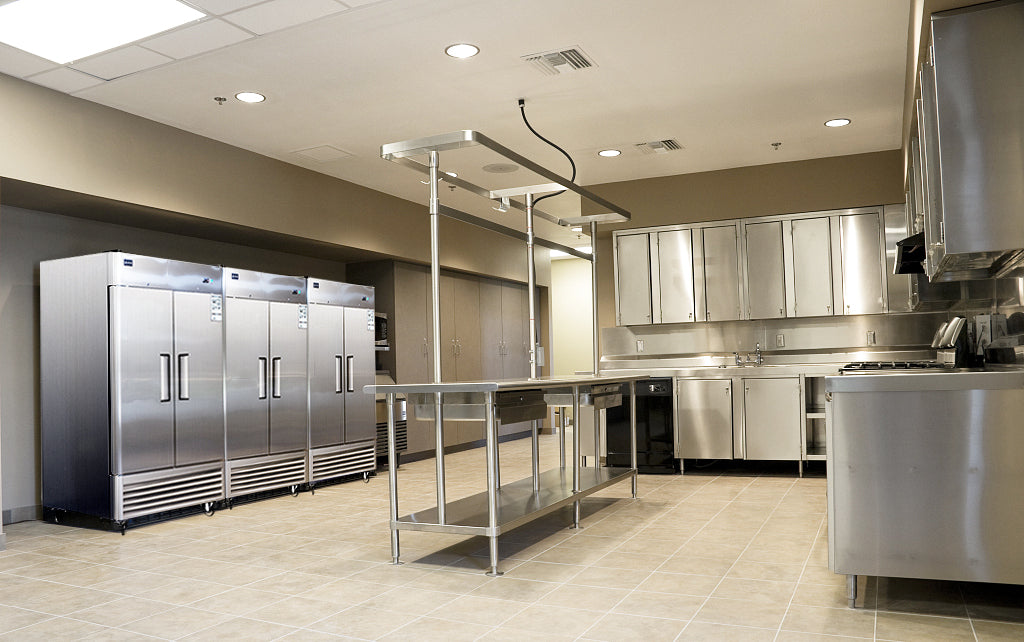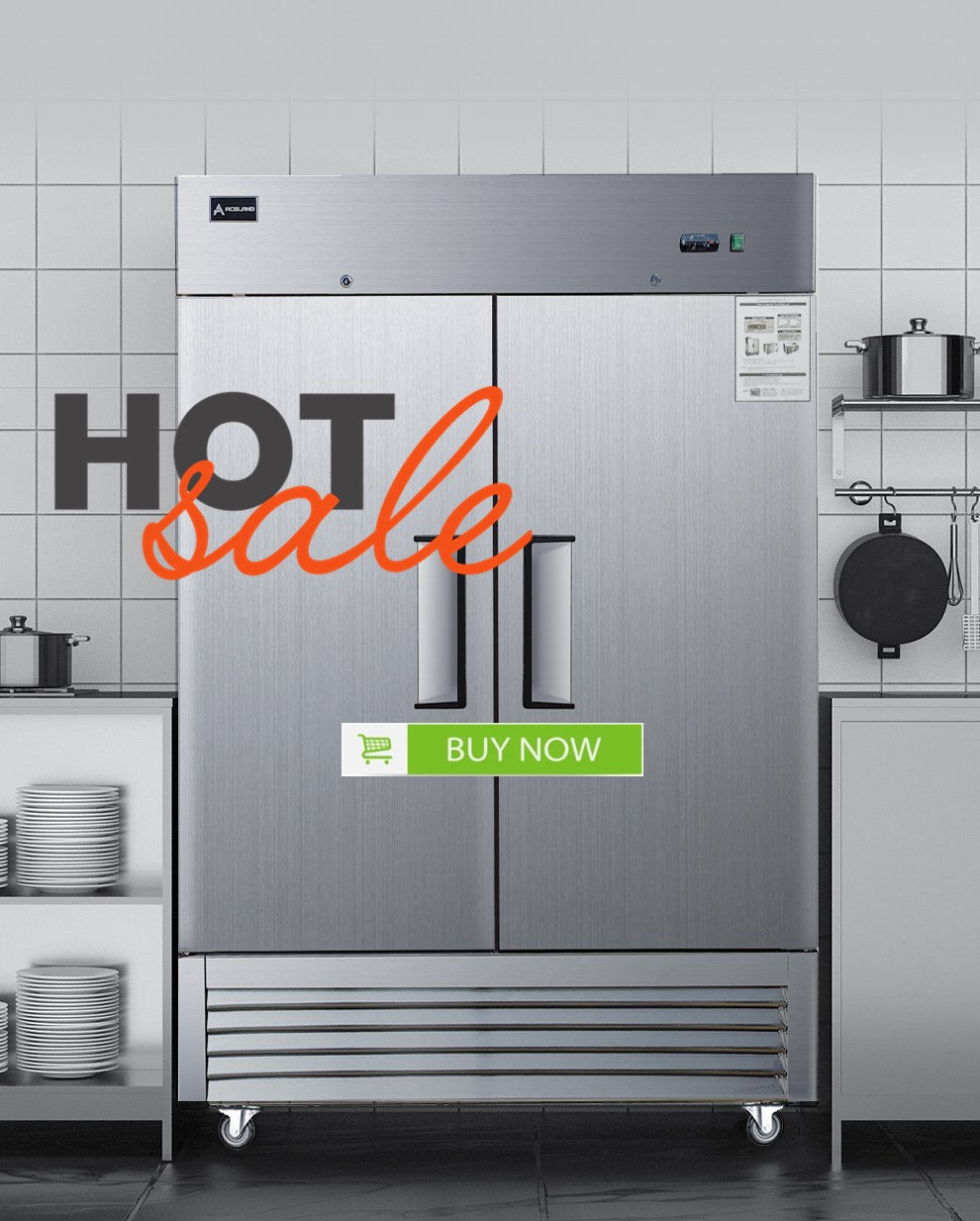Essential kitchen equipment all restaurants needs
Choosing the right kitchen equipment is essential for the success of a new restaurant or when renovating an existing one. Depending on the type of restaurant you operate, you may need to invest in items like fine china or additional deep fryers. We've put together a detailed list of must-have restaurant equipment to help you begin outfitting your kitchen. While this list covers the basics that most restaurants will require, you can customize it further to suit your specific needs.
1. Cooking Equipment
Commercial kitchen equipment in a restaurant
Cooking equipment is essential in any professional kitchen, no matter the type of restaurant. When selecting cooking equipment, consider the items you use most frequently. Although smaller equipment may seem more affordable initially, it may not meet your capacity needs for frequent use, leading to higher costs over time. Additional components like gas hoses might be necessary for proper installation.
-
Oven: A crucial appliance for tasks such as baking, roasting, and braising. There are different types, including pizza ovens and combi ovens.
-
Range: A combined cooktop and oven that allows you to bake, saute, boil, roast, or broil. You can choose between electric or gas options based on your kitchen’s setup.
-
Deep Fryer: Ideal for making dishes like French fries, chicken tenders, or even deep-fried turkey.
-
Grill: Adds a smoky, charred flavor to meats and vegetables with charbroilers and other grill types.
-
Griddles: A flat cooking surface for preparing dishes like scrambled eggs, Philly cheesesteaks, or burgers.
-
Holding Equipment: Cabinets that keep food at the desired temperature, ideal for storing food until it’s ready to serve or proofing bread.
-
Salamander or Broiler: Used to finish dishes, toast bread, melt cheese, or broil foods like salmon.
-
Toaster: Essential for breakfast service, making it easy to toast bread or bagels.
-
Microwave: A convenient tool for reheating sauces, defrosting frozen foods, or quickly reheating meals.
2. Beverage Equipment
Serving drinks is just as vital as serving food, particularly in coffee shops, bars, or juice bars. However, standard restaurants also need certain beverage equipment to meet customer needs.
-
Coffee Brewer: A necessary item for any restaurant, as coffee is a popular beverage even if you're not running a cafe.
-
Beverage Dispensers: Common in fast food or fast casual restaurants for self-service or at wait stations. Consider the brands and beverage options to be served.
-
Ice Machine: Crucial for keeping drinks cold at restaurants, cafes, or bars. Beverage-focused businesses also use ice for smoothies or cocktails.
3. Refrigeration Equipment
Refrigeration equipment comes in various styles and types, each suited to different needs based on the size and type of restaurant. An efficient refrigerator and freezer are key elements in a well-functioning kitchen.
-
Refrigerator: Types include walk-in coolers, reach-in fridges, pass-through options, and prep fridges, depending on your needs.
-
Freezer: Freezers also come in different sizes and styles, and proper cold storage is necessary to prevent cross-contamination.
4. Storage Equipment
Efficient storage equipment helps keep your kitchen organized, boosting productivity and safety. Following proper food storage guidelines ensures food safety.
-
Shelving: Use shelving in coolers or freezers for storing food, or in kitchens for easy access to cookware and ingredients. Shelves are available in various sizes for customization.
-
Bussing and Utility Carts: Useful in both front-of-house and back-of-house areas for moving equipment or bussing tables.
-
Sheet Pan Racks: Designed to store and transport food, as well as proof bread. They are space-efficient in tight kitchens.
-
Food Storage Containers: Great for storing prepped ingredients, mixing sauces, or holding dry ingredients like pasta or rice.
-
Drying Racks: Store and air-dry cookware, utensils, and glassware.
-
Dunnage Racks: Elevate heavy items like canned goods or rice for added stability and proper air circulation.
5. Food Prep Equipment
Food prep equipment is essential for streamlining your kitchen operations, improving efficiency for various food preparation tasks.
-
Food Processors: Versatile machines that reduce prep time by helping with chopping, slicing, and mixing ingredients.
-
Prep Tables: Sturdy surfaces for preparing ingredients or assembling dishes.
-
Mixers: Vital for bakeries or pizza shops, but helpful in any kitchen to improve food prep efficiency.
-
Spice Grinders: Freshly ground spices enhance the flavor and depth of your dishes.
-
Blenders: Useful in bars or cafes for making drinks, sauces, or marinades.
6. Smallwares
Smallwares, or cookware, are essential kitchen tools for preparing and cooking dishes. When purchasing these items, ensure you have the right quantity to avoid shortages during service.
-
Chef Knives: A sharp set of knives is a must for smooth food prep and to avoid accidents.
-
Cutting Boards: Use different colored cutting boards for various tasks to prevent cross-contamination and follow food safety guidelines.
-
Mixing Bowls: Multiple sizes are essential for different prep tasks like mixing or whisking ingredients.
-
Pans: A variety of pans (sauce, sauté, braising, frying) is necessary for different cooking needs.
-
Pots: Different types of pots, such as stock pots, pasta cookers, and sauce pots, are essential for various cooking methods.
-
Whisks: Incorporate air into ingredients for lighter textures with the right whisk.
-
Food Pans: Used for oven cooking or holding food at the correct temperature until ready to serve.
-
Kitchen Spoons: Versatile tools for stirring, serving, or removing ingredients.
-
Turners: Useful for flipping food on griddles or grills, helping avoid burns.
-
Tongs: Versatile tools for food prep, serving, and plating.
7. Janitorial Equipment
Maintaining cleanliness is crucial in any foodservice environment, and a well-stocked janitorial supply helps keep your establishment sanitary.
-
Microfiber Cloths and Cleaning Rags: Essential for wiping down surfaces, cleaning spills, and polishing.
-
3 Compartment Sink: Needed for washing, sanitizing, and rinsing, adhering to health regulations.
-
Foodservice Chemicals and Sanitizers: Proper cleaning and sanitizing chemicals ensure a safe environment.
-
Trash Cans and Recycling Bins: Necessary for proper waste disposal, placed strategically throughout the premises.
-
Mops and Mop Buckets: For cleaning floors after service.
-
Wet Floor Signs: To warn of slippery conditions and prevent accidents.
-
Scrubbers and Sponges: For cleaning tough messes or delicate items, depending on the abrasive needs.
-
Restroom Supplies: Ensure stock of toilet paper, paper towels, soap, and other necessities.
-
Brooms and Dustpans: For sweeping up food debris and maintaining cleanliness.
-
Cleaning Chemical Buckets: Use color-coded buckets to safely mix and organize cleaning chemicals.
























